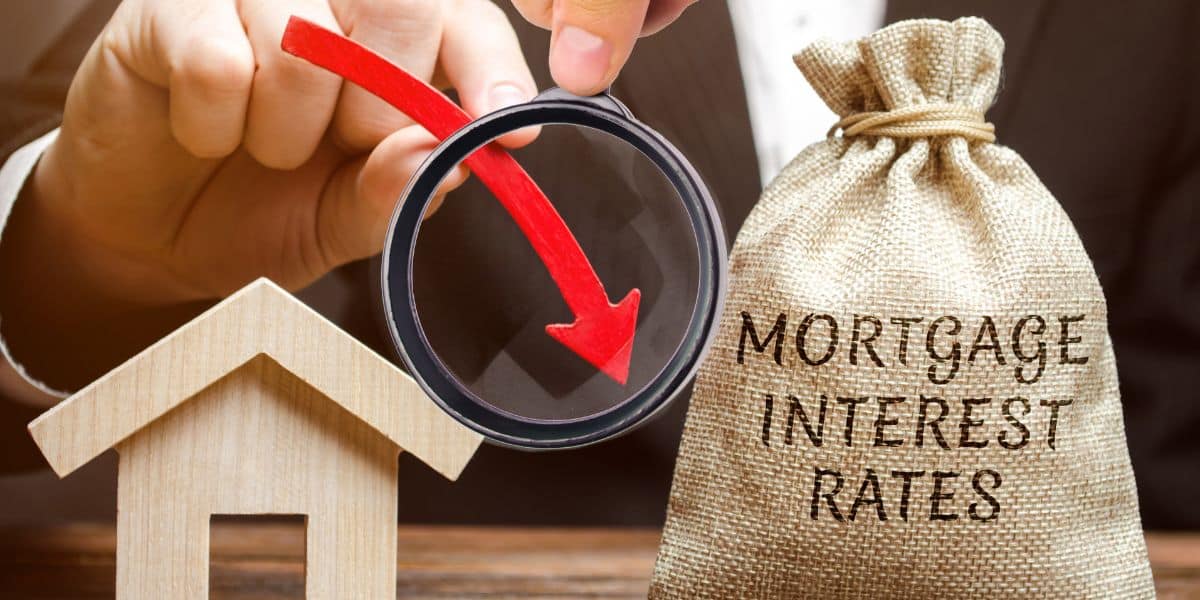As the U.S. economy slows down, inflation falls and the Federal Reserve lowers interest rates, mortgage rates will likely decline in the second half of this year. Interest rates will remain high until the Fed can see evidence of a slowing in economic growth.
By the end 2024, the 30-year fixed rate mortgage is likely to drop to a range of mid-6%. It could even dip into the high-5% area by 2025. Recent economic developments, however, have led some to predict that rates will stay high at around 7% through the rest of this year.
Here is where the mortgage rates will be in 2024, and how this will affect the housing market.
When will mortgage rates go down?
The Federal Open Market Committee is expected to reduce the benchmark interest rate in the second half 2024. As long as the Fed is concerned about inflation, mortgage rates will continue to be high.
Sam Khater is Freddie Mac’s Chief Economist. In a statement dated May 9, he said that “An environment in which rates continue to hover over seven percent affects both buyers and sellers.” Many potential sellers are hesitant to sell their homes and give up the lower mortgage rates of years past, negatively impacting supply and maintaining house prices. The high house prices are adding to the affordability issues that buyers are facing in this high rate environment.
The majority of economists believe that the rates will gradually fall to the mid-6% level by the end of the year, but some predict rates to stay high around the 7% mark. What do experts think about this year’s predictions?

Fannie Mae: Rates Will Stay Around 7%
Fannie Mae’s May Household Forecast puts the 30-year fixed rates at or above 7 percent for the rest of 2024. This Forecast shows an upward revision to its analysis. A month earlier, Fannie predicted rates would drop to 6.4% at year-end. And just a few short months ago, Fannie forecast rates would drop below 6% before the end of the year. Fannie Mae estimates that mortgage rates will be 7% on average in 2024, and 6.7% by 2025.
MBA: Rates will drop to 6.5%
The Mortgage Bankers Association, in its May Mortgage Finance Outlook predicts that rates on mortgages will drop from 6.9% at the end of the second quarter 2024 to just 6.5% by the end of the fourth quarter. The industry group anticipates that rates will drop below the 6% mark by the end of 2025.
NAR: Rates will drop to 6.5%
According to the latest Quarterly U.S. Economic forecast, the National Association of Realtors predicts that mortgage rates will average 6,8% in the first three quarters of 2024 and rise to 7,1% in the second. The trade association expects rates to fall in the second quarter of the year and reach 6.5% by the fourth.
Realtor.com: Rates will drop to 6.5%
In a Housing Market Forecast, the real estate listings site Realtor.com predicted that rates would average 6.8% in this year and drop to 6.5% at the end of 2024.
Wells Fargo: Rates will lower to 6.5%
In its most recent U.S. The Economics Group of Wells Fargo Bank estimates that the 30-year conventional loan rate will be 7.05% at the end of 2024. Wells Fargo’s economists expect the average mortgage rate to drop below 6% by the end of 2025.
Why mortgage rates are expected to stay higher for longer
The Fed was battling to keep inflation at its 2% target despite positive economic growth. This led to stubbornly high mortgage rates. The central bank increased the federal funds rate seven times in 2022, and four more times in 2023. Its latest rate hike of 25 basis points came at its July meeting.
The Fed has ended its tightening cycle. Policymakers at the May 2024 meeting voted to keep the target range unchanged, i.e. 5.25%-5.50%. Fed Chair Jerome Powell stated at a news conference on May 1, that another rate increase is “unlikely,” however, policymakers were “prepared” to maintain the federal funds target range as long as it was appropriate.
In March, the Fed released its latest projecting materials. The documents show that the Fed still expects three rate reductions in 2024. This would bring the rate down to three-quarters a percentage point at the end of this year. The Fed’s economic policies are not set in stone. Policymakers could adjust their course if the economy starts to heat up.
Rate cuts in 2024 are more likely to occur than previously believed, but not as quickly as originally thought. Many economists thought that rate cuts would start in March, and then May, then at the latest June. Now, economists from Freddie Mac and Wells Fargo believe that the FOMC is going to cut rates this September.
The abnormally wide spread between the rate of the 30-year fixed-rate mortgage and the yields on the 10-year Treasury Bonds is another reason why mortgage rates will fall. This spread has historically been around 170 basis points, but was closer to 300 in most of 2023.
Treasury yields have been moderated in recent months. If spreads return to “normal”, mortgage rates will be closer to 6%. Spreads are not expected to fall below 170 points any time soon, but they should decline a bit this year. This will bring mortgage rates down to the low 6% range.
MBA economists report that mortgage-Treasury yield spreads are now at a level of 250 basis points. This is still a large amount compared to historical averages, but it’s notably better than last year’s 300 basis point level. We expect that the spread will continue to tighten by the end 2024.

Advice on Buying and Selling a House in 2024
The mortgage rates will likely remain higher until the end of this year or next. This has implications for both prospective buyers and sellers. Regardless of the current trends in mortgage rates, Americans are still motivated to move.
The housing market is not always a place where patience pays off. According to a U.S. survey conducted in March, two-thirds (67%) of homebuyers will wait for the mortgage rate to drop this year before purchasing a house.
According to Freddie Mac’s data, rates increased last year. They reached a new high of 7.79% at the end of October before falling a full percentage to 6.6% by the year-end. In the first quarter of 2024, the rates began to rise amid unexpected economic strength. They hovered around the 7% level once more.
Home prices continued to increase during the period that homebuyers waited for lower interest rates. According to the S&P Case-Shiller Home Price Index, national home prices rose 6.5% from March 2023 to March 2024. The S&P CoreLogic Case-Shiller Home Price Index predicts that home prices will stabilize in 2019 – but not crash.
Here are some home price predictions for 2024 from the top housing groups in the United States:
- CoreLogic: Prices of homes will increase by over 4% between 2024 and 2025.
- Fannie Mae says home prices will increase by 4.8% in 2020 and 1.5% in 2030.
- Freddie Mac: Prices of homes will increase by 0.5% between 2024 and 2025.
- NAR: Home price will increase 0.9% to $389.500 in 2024.
- Zillow: Home price will remain stable this year and decrease by 0.2%.
Home prices won’t drop much, but they aren’t expected to continue rising at double-digit rates like in 2021 or 2022. Buyers can expect to have more options to choose from, as home values won’t be driven through the roof by bidding wars.
It’s not that the market will be a buyers’ market, but at least there should be more balance between sellers and buyers. The buyer may not have to give up important protections such as appraisal conditions or home inspection. The existing inventory of homes is expected to increase (at least slightly) as interest rates continue to fall and homeowners who were previously locked into a rate will decide to sell.
Also, there may be less competition for buyers in the brand new home construction sector. Although homeowners may not want to give up their low mortgage rate, homebuilders are eager to make the sale. Builders may offer price reductions, or even temporary buydowns.
The biggest obstacle for sellers is the fact that they need to find a new home after they have sold their old one. Many people will have to buy a new house at current rates and prices.
According to the Federal Housing Finance Agency, the average rate of existing mortgages is 4,1%. This is about three percentage points lower than the rate that new homebuyers are currently paying. According to the Federal Housing Finance Agency, 87% have rates below 6%. Rates are not expected to drop below this threshold.
Zillow says that although many sellers are reluctant to abandon their low-interest mortgage rates, the effect of rate locking will diminish this year. This is because some homeowners get tired of waiting.
A survey by Fannie Mae in 2023 suggests that the low interest rates are not the only thing keeping people from moving. A fifth of mortgage borrowers say their low mortgage rates are causing them to stay in their homes longer. Nearly as many (19%) said that they like their current home. Unsurprisingly, 13% of mortgage borrowers say that their low interest rate is causing them to stay in their home longer.
There is some good news for homeowners who are both sellers and buyers. Most of them have accumulated a lot of equity over the years, thanks to home prices increasing by double digits. A successful sale allows homeowners to use that equity for their next home purchase.

What this Means for Mortgage Rates
The forecast to refinance mortgage rates will be similar to the forecast for purchase mortgage rates. They are likely to decrease this year but won’t reach the lows of the pandemic era anytime soon. It doesn’t make sense for homeowners to refinance at this time, as they already have a rate that is lower than the current rate.
Recent homebuyers would be the exception, as they borrowed at high mortgage rates in 2022 or 2023. According to the U.S., the vast majority of Americans (84%) who purchased a home in September 2022 or September 2023 intend to refinance at a lower interest rate.
It’s still possible to refinance, even if you don’t want to just get a lower interest rate. You can refinance to a shorter term, such as a fifteen-year mortgage. This can allow you to pay off your mortgage quicker and save you money over time, as you will be paying less interest to the lender. If your new rate is significantly higher, then it may not be worth it in the long run, as you may find that your monthly payments are much more expensive.
Some people may refinance to convert from an adjustable rate mortgage (ARM) to a fixed rate mortgage. You can avoid higher monthly payments by refinancing into a fixed-rate mortgage. This can help you budget your housing costs. Fixed rates are usually higher than adjustable rates. It may be hard to justify refinancing, unless the ARM rate will increase significantly.
Some homeowners might also want to refinance in order to tap into their home’s equity. This is possible if your home has appreciated in value or you have paid down your mortgage significantly over the past few years. You will be taking on more debt and a bigger loan, which means you’ll pay more in interest over time. You’ll also be stuck with the higher interest rate.

